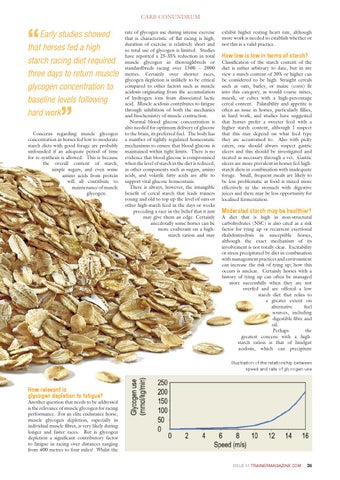CaRb CONUNdRUm
“
Early studies showed that horses fed a high starch racing diet required three days to return muscle glycogen concentration to baseline levels following hard work
�
Concerns regarding muscle glycogen concentration in horses fed low to moderate starch diets with good forage are probably unfounded if an adequate period of time for re-synthesis is allowed. This is because the overall content of starch, simple sugars, and even some amino acids from protein will all contribute to maintenance of muscle glycogen.
rate of glycogen use during intense exercise that is characteristic of flat racing is high, duration of exercise is relatively short and so total use of glycogen is limited. Studies have reported a 25-35% reduction in total muscle glycogen in thoroughbreds or standardbreds racing over 1500 – 2000 metres. Certainly over shorter races, glycogen depletion is unlikely to be critical compared to other factors such as muscle acidosis originating from the accumulation of hydrogen ions from dissociated lactic acid. muscle acidosis contributes to fatigue through inhibition of both the mechanics and biochemistry of muscle contraction. Normal blood glucose concentration is also needed for optimum delivery of glucose to the brain, its preferred fuel. The body has a number of tightly regulated homeostatic mechanisms to ensure that blood glucose is maintained within tight limits. There is no evidence that blood glucose is compromised when the level of starch in the diet is reduced, as other components such as sugars, amino acids, and volatile fatty acids are able to support vital glucose homeostasis. There is always, however, the intangible benefit of cereal starch that leads trainers young and old to top up the level of oats or other high-starch feed in the days or weeks preceding a race in the belief that it just may give them an edge. Certainly anecdotally some horses can be more exuberant on a highstarch ration and may
exhibit higher resting heart rate, although more work is needed to establish whether or not this is a valid practice.
How low is low in terms of starch?
Classification of the starch content of the diet is rather arbitrary to date, but in my view a starch content of 30% or higher can be considered to be high. Straight cereals such as oats, barley, or maize (corn) fit into this category, as would coarse mixes, muesli, or cubes with a high-percentage cereal content. Palatability and appetite is often an issue in horses, particularly fillies, in hard work, and studies have suggested that horses prefer a sweeter feed with a higher starch content, although I suspect that this may depend on what feed type they are accustomed to. also with picky eaters, one should always suspect gastric ulcers and this should be investigated and treated as necessary through a vet. Gastric ulcers are more prevalent in horses fed highstarch diets in combination with inadequate forage. Small, frequent meals are likely to be less problematic as food is mixed more effectively in the stomach with digestive juices and there may be less opportunity for localised fermentation.
Moderated starch may be healthier?
a diet that is high in non-structural carbohydrates (NSC) is also cited as a risk factor for tying up or recurrent exertional rhabdomyolysis in susceptible horses, although the exact mechanism of its involvement is not totally clear. Excitability or stress precipitated by diet in combination with management practices and environment can increase the risk of tying up; how this occurs is unclear. Certainly horses with a history of tying up can often be managed more successfully when they are not overfed and are offered a low starch diet that relies to a greater extent on alternative fuel sources, including digestible fibre and oil. Perhaps the greatest concern with a highstarch ration is that of hindgut acidosis, which can precipitate Illustration of the relationship between speed and rate of glycogen use
How relevant is glycogen depletion to fatigue?
another question that needs to be addressed is the relevance of muscle glycogen for racing performance. For an elite endurance horse, muscle glycogen depletion, especially in individual muscle fibres, is very likely during longer and faster races. but is glycogen depletion a significant contributory factor to fatigue in racing over distances ranging from 400 metres to four miles? Whilst the ISSUE 51 TRAINERMAGAZINE.COM
EUROPEAN TRAINER ISSUE 51 CARB.indd 35
35
25/09/2015 08:15
